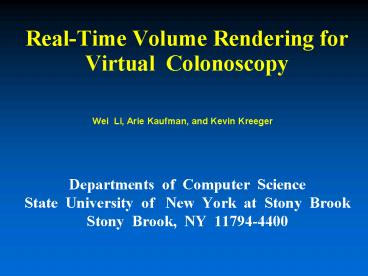RealTime Volume Rendering for Virtual Colonoscopy - PowerPoint PPT Presentation
1 / 33
Title:
RealTime Volume Rendering for Virtual Colonoscopy
Description:
RealTime Volume Rendering for Virtual Colonoscopy – PowerPoint PPT presentation
Number of Views:59
Avg rating:3.0/5.0
Title: RealTime Volume Rendering for Virtual Colonoscopy
1
Real-Time Volume Rendering for Virtual
Colonoscopy
Wei Li, Arie Kaufman, and Kevin Kreeger
- Departments of Computer Science
- State University of New York at Stony
Brook - Stony Brook, NY 11794-4400
2
Outline
- Introduction
- The slab structure
- Slab-Based Volume Rendering
- Warping and Caching of Slab Images
- Experimental Results
- Future Work
3
Introduction
- Virtual Colonoscopy
4
Screen shot of the system
5
Introduction
- Challenges
- High quality image
- Large data set
- Interactive Rendering Speed
6
Related Work
- High-end parallel computers
- You 97, Wan 97
- Texture mapping hardware
- 3D texture, 2D texture
- Image-based rendering
- Brady 97, Mueller 99
- Dedicated hardware
- VIZARD II, VolumePro
7
Observations
- Colon is tortuous
- Colon wall is opaque
- 1/5 of voxels are inside the colon
- The camera stays inside the colon
- A small percentage of voxels are visible to a
given view point.
8
Overview of our approach
- Pre-processing
- Axis-aligned slabs
- Portals
- Rendering
- Visibility culling
- Render or warp slab images
9
Outline
- Introduction
- The slab structure
- Slab-Based Volume Rendering
- Warping and Caching of Slab Images
- Experimental Results
- Future Work
10
The slab structure
- A slab is a sub-volume bounded by an axis-aligned
box. - A slab contains as few non-internal voxels as
possible.
11
Slab Sets of Colon Volume
- Three sets of slabs.
- One set for each major axis
12
Portals
On every shared face of each adjacent slabs, we
define a portal. The portal is the bounding box
of the cross-section of a colon on that shared
face.
13
Construction of the Slabs
- Slice the volume with equidistant parallel planes
perpendicular to a major axis. - Find all the connected regions of internal voxels
between the adjacent planes. - The bounding box of the connected regions define
the slabs. - The process is repeated three times. One for each
of the three axes.
14
Construction of the Slabs (2)
- Create a binary volume from the original dataset.
- Compress the binary volume by merging slices.
- Apply 2D region grow on the slices of the
compressed volume
15
Compressed Binary Volume
16
Creating the slabs
17
Complexity of the Algorithm
- The algorithm tries to do region grow for all
(internal) voxels - Each voxel is inspected only once for whether a
region grow is necessary. - Each internal voxel is flagged once
- Time complexity is linear to the number of voxels.
18
Outline
- Introduction
- The slab structure
- Slab-Based Volume Rendering
- Warping and Caching of Slab Images
- Experimental Results
- Future Work
19
Slab-based Volume Rendering
- Determine which set of slabs to use
- Visibility detection
- Obtain the slabs images
- Blending the slab images
20
Visibility Detections
- Project the view frustum to the volume
coordinates - Intersect the view frustum with the portals.
- Faster and more accurate than projecting portals
to the eye coordinates
21
The Blending of Slab Images
22
The Blending of Slab Images (2)
23
Warp the slab images
- Why?
- To reuse the slab images from nearby view points
- To simulate perspective projection with parallel
hardware
24
Warping based on portal model
25
Warping based on depth image
26
Two-Level Caching of the Slab Images
- Cache in graphics memory
- To save the time for transfer slab images from
host memory to graphics memory. - (OpenGL texture object)
- Cache in host memory
- To save the time for volume rendering slabs
27
System Performances
- Pure VolumePro
- 0.5 FPS
- Slab images cached in host memory
- 10 FPS
- Slab images cached in host and graphics memory
- 100 FPS (Without warping)
28
Performances(2)
- Slab Images Cached by both Host and Graphics
Memory - No Warping
- gt100 FPS
- Warped with mesh of grid size of 22 voxels
- gt50 FPS
- Warped with mesh of grid size of 11 voxel
- 10 15 FPS
29
Images
30
Properties of the Slab Structure
- Easy to create
- Empty space skipping.
- Occlusion culling
- Slab images can be reused
- Approximate perspective rendering with parallel
projection.
31
Discussion and Future work
- With slab-based volume rendering, real time
rendering of high resolution images can be
achieved - There are artifacts.
- Aliasing when switching slab sets
- Discontinuity between slab images
32
Acknowledgement
- NIH grant CA82402
- Naval Research grant N00014011034
- E-Z-EM Inc
- Viatronix Inc.
- University Hospital of Stony Brook.
- Min Wan, Baoquan Chen, Klaus Mueller, Manuel
Oliveira and others - Anonymous reviewers.
33
Thank You!

